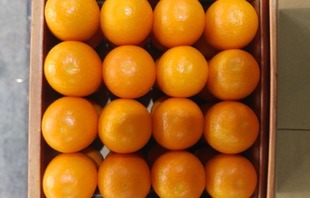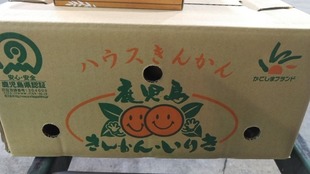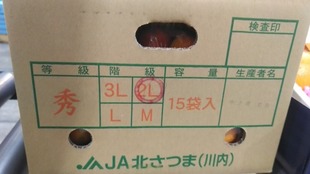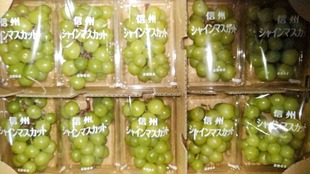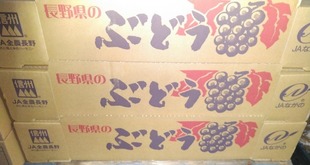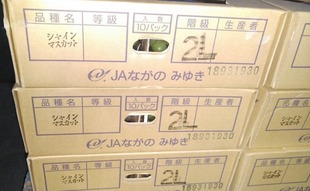【Product name】
Toyama dried persimmon(Japanese wisdom)
【Type】
Diospyros kaki Thunb.
【Wholesale area】
Takamiya, Nanto City, Toyama Prefecture (Toyama Dried Persimmon Shipping Association Federation)
【Origin of name】
Facing the Sea of Japan in the Chubu region. From three persimmons native to the Fukumitsu region of Nanto City, Toyama Prefecture (Echu). The name “rolling persimmon” comes from the fact that when peeled persimmons are lined up in the garden and dried in the sun, the positions of the persimmons are changed at appropriate intervals so that the entire persimmon is exposed to the sun. It seems that it is said that there is. In addition, dried persimmons are generally called KORO persimmons, but the etymology of the persimmons is that they have a round shape or are made by rolling them, so there are theories such as the meaning of persimmons and the meaning of persimmons (powdered persimmons). Hiratanenashigaki: Around 1887, persimmon saplings bought from a merchant in Echigo were cultivated in the Shonai region of Yamagata prefecture by the former Tsuruoka feudal lords, but it seems that they were named after their excellence in 1909.
【Major features】
Nanto City’s world heritage site, Ainokura thatched roof house cluster, is a historical landscape of Gokayama (former Taira Village, former Kamitaira Village, and former Toga Village), where gassho-zukuri from about 100 to 350 years ago are lined up. Precious and beautiful to leave in. Thatched roof house is a very valuable private house that can only be seen in this neighborhood in Japan, and there are still 20 building thatched roof houses. There are many attractions such as the only remaining prototype, the primitive principal rafter, thatched roof house houses of various sizes, and thatched temples. People still live in the village, and the old-fashioned life is still alive. The appearance of snuggling up to the changing seasons is always beautiful, but especially the pure white silver world where the entire village is covered with winter snow is very divine. It is a must-see for the seasonal illuminations, and it seems that you can enjoy the extraordinary life by being fascinated by the fantastic space. In the village, there are Ainokura Folk Museum, Ainokura Traditional Industry Museum, Japanese washi Making Experience Center, etc. This year, it will be fully operational every day until early December, aiming to produce 400,000 units. It seems that it is responsible for the cultivation and processing of persimmons in a field of about 8.5 hectares, which has become difficult to cultivate due to the aging of producers. I heard that the processing facility completed in May this year will be able to carry out all processes from peeling to drying and packaging consistently, which will enable labor saving and uniform quality. It seems that it plans to obtain a Japanese food safety standard, JFS-B(Food safety standard developed in Japan. He has three layers of requirements: Management System (FSM), Hazard Control (HACCP), and Good Manufacturing Practice (“GMP”). Also includes HACCP institutionalized by the revised Food Sanitation Law (June 2018). It has a step-by-step system that is easy for small and medium-sized enterprises to work on. Guidelines that explain the standards in an easy-to-understand manner are in place. We are trying to align domestic regulations with international certification standards. I heard that it has a mechanism to utilize improvement proposals from the field.)conformity certification by the end of this year. On the first day, 5,000 persimmons were brought to the facility, and 20 employees seemed to work while checking the procedure from peeling to putting them in the drying room, which also served as a test. It seems that 30 people process 10,000 pieces a day at the peak. Due to the operation of the new processing facility, the production volume of partially dried Japanese persimmon in 2021 is expected to increase by 40% from the previous year to 1 million pieces. It will be shipped through the Toyama Dried Persimmon Shipping Association, which will be introduced this time. Toyama Dried Persimmon: Eco-Pharma Certified Toyama Prefecture Furusato Certified Food, Eco-Pharma Certified. “Environmentally friendly farmer (as recognized by law)” is a highly sustainable agricultural production method (soil preparation, reduction of chemical fertilizers and pesticides) based on the “Act on Promotion of Introduction of Highly Sustainable Agricultural Production Method”. Produced by farmers who have been certified by the prefectural governor with a plan to introduce an integrated production method). Amid growing consumer needs such as safety and security and genuineness, the prefecture has set standards for high-quality processed agricultural, forestry and fishery foods produced in the prefecture, and puts a certification mark (commonly known as the E mark) on foods that meet these standards. By doing so, it is said that the image of the prefecture’s special products is being improved and information is being disseminated nationwide as “Toyama’s special products”. Certification requirements: Raw materials required must be 100% produced in Toyama Prefecture. The manufactured factory, etc. is located in Toyama Prefecture. Excellent quality as food. Certification mark: Excellent quality, accurate display Exact expression, harmony with the local environment Harmony with Ecology, 3 Es are placed in the form of “goods” to indicate that they are “good goods”. Currently, it has set certification standards for 39 items and is certifying 233 products. (As of the end of October 2021) [Agricultural products] Rice confectionery, mochi made in winter, raw rice cake, sake, Kaburazushi, pickled agricultural products, edible vegetable oils and fats, dried persimmons, jams, tofu, fried rice, rice miso, tea, breads, dried noodles, wine, bean confectionery, fruit and vegetable beverages, boiled beans, dried vegetables and fruits, baked confectionery, sushi, seasoned miso, persimmon vinegar / persimmon vinegar seasoning, Gohei mochi. [Livestock products] Loin ham, pork sausage, roast pork, ice cream, pork dumplings, cooked eggs, pudding. [Marine products] Firefly squid pickled in soy sauce, salted firefly squid, white shrimp kelp, Japanese amberjack, Japanese white radish, dried fish, dried seafood, and kakiage. Items to be added: Frozen hamburger steak, frozen croquette, natural cheese, yogurt, Japanese fried chicken. It seems that you can apply for items to be added. Minister of Agriculture, Forestry and Fisheries Registration No. 98: Toyama Dried Persimmon GI Product Registration: Geographical Indication (GI) Protection System, high quality due to special production methods cultivated over many years in the region and characteristics of production areas such as climate, climate and soil There are many products that have won the reputation. Of these products, the “Geographical Indication Protection System” is a system that registers and protects the names of products whose quality, social evaluation, and other established special products are linked to the place of origin as intellectual property. “Nanto City, Toyama Prefecture”, Located in the southwestern part of Toyama prefecture. Mt. Yaotome (Nanto City, Toyama Prefecture): some proposed “Yaotome City” for the name of the new city formed through a municipal merger known as “the Great Merger of the Heisei Era,” but the municipal assembly adopted “Nanto City” by a majority vote. The area is 668.64 km2 (about 26 km east-west, about 39 km north-south). About 80% of them are forests including Hakusan National Park. It is blessed with abundant nature, such as the rapids of the Sho River and oyabe river flowing north from the mountains that border the Gifu Prefecture. In the northern plains, the beautiful “SANKYOSON”(Dispersed settlement : Private houses are scattered in the vast cultivated land. Ainokura (Gokayama), Nanto City, 1994, mountain village. Suganuma (Gokayama), Nanto City, 1994, mountain village.)” landscape spreads out in the paddy fields, forming a unique village landscape. An area with a climate on the Sea of Japan side, with cold winters and heavy precipitation and snowfall. In the plains, it blocks strong winds and typhoons in early spring, snow in winter, and hot sunlight in summer : Houses in the premise forest called “Kainyo” peculiar to the dispersed settlement. The area has a long history, and many archaeological sites centered on the Paleolithic period about 30,000 to 20,000 years ago have been excavated from the Tatenogahara Plateau(富山県教育委員会, 1978.3/31,『富山県福光町・城端町, 立野ヶ原遺跡群, 第六次緊急発掘調査概要』 ). About 30 Paleolithic ruins have been confirmed(Remains of pit dwellings, etc.). During the Nara and Heian periods, villas developed in the plains of the Oyabe River basin. The Takase archaeological site located in the southern part of Takase Shrine : Excavation of earthenware such as Sue pottery and Hajiki pottery and bronze coins. In addition, a group of buildings with moat pillars, which are thought to be the remains of the manor’s government office, have been found. Zuisenji Temple(In 1390, Shakunyo(He was the 5rd chief priest of Jodo Shinshu (the True Pure Land Sect of Buddhism) Hongan-ji School.), the fifth chief priest, built Zuisen-ji Temple (Nanto City) in Inami, Ecchu Province (Toyama Prefecture). During the Warring States period, it was the base of Etchu Ikkō-ikki.) was built in the Middle Ages. When Zentoku Temple(加賀国河北郡井家庄, 越中国法林寺村, 福光村を経て, 永禄年中に, 現在の城端へ移る。蓮如上人 : Bronze statue of Rennyo Shonin (made by Koun TAKAMURA(東京美術学校教授, 帝室技術員) in 1934). Assumed the 8th Monshu of the Hongan-ji school of the Jodo Shinshu sect. Yoshizaki Gobo(1471年: 文明3年)was a priest housing which stood in Yoshizaki of Echizen Province (present Yoshizaki, Awara City, Fukui Prefecture). The fire attack against Mt. Hiei was a fire attack mainly against Mt. Hiei. In 1975, it was designated as a national historic site and maintained as a park. A land shared by both East and West.)moved from Kaga, the former Inami Town and the former Jobata Town prospered as gate towns. In the plains, newly reclaimed rice field development will proceed under the control of the Kaga domain. etc. 干柿の製法が, 慶長年間(1596年~1615年)に, 美濃国(岐阜県)から伝えられた(美濃吊るし柿)とされ, 江戸時代時の, 加賀3代藩主「前田利常(Toshiie MAEDA : He had children including the first Kaga Hanshu Toshinaga MAEDA, the second Hanshu Toshitsune MAEDA, and others. Toshinaga adopted his smaller brother Toshitsune MAEDA as his son, and he retired, after transferring the reigns of the family to Toshitsune. In the Edo period, Toshitsune MAEDA rebuilt it as a Buddhist temple(A clean place where monks gather and practice)and the Shuinjo (shogunate license to conduct trade) was issued. While staying at a camp in Nagoya Castel during the Bunroku-Keicho War, Toshiie flirted with her and made her his concubine, and she later gave birth to Toshitsune MAEDA, the third head of the Maeda clan.(While staying at a camp in Nagoya Castel during the Bunroku-Keicho War, Toshiie flirted with her and made her his concubine, and she later gave birth to Toshitsune MAEDA(Saruchiyo: Juhukuin(OChiyo nokata)’s son), the third head of the Maeda clan.)」公(1594年〜1658年)が (現: 南砺市(旧西となみ郡)福光地区(Designated as a special heavy snowfall area. Maximum snow depth can exceed 3 m in mountainous areas..), When I came to falconry in the Johana area, Ichio gave me a handmade dried persimmon, which was highly praised. Since then, the Maeda family has always been encouraged to make dried persimmons, and it is said that the traditional dried persimmons that continue to be made in this area have become popular. 富山干柿(三社柿)は, 医王山から吹き降ろす西風「医王おろし: Mt. Iozen(日本三百名山(1978年)及び新・花の百名山(1995年)に選定. Ryohaku Mountains: It is one of the most heavy snowfall areas in Japan, belongs to Hakusan National Park(Designated by the Ministry of the Environment on July 1, 1955(Quasi-National Park): November 12, 1962 Changed to a national park.), and has an altitude of 1617m. “Taicho” opened the mountain: Taicho (July 20, 682 – April 20, 767) was a shugendo (Japanese mountain asceticism-shamanism incorporating Shinto and Buddhist concepts) priest who lived during the Nara period. According to “Taicho-osho-den” (Biography of Priest Taicho) compiled at a later time, Taicho climbed Mt. Ochi at the age of 14 for training while praying to Eleven-faced Kannon (Goddess of Mercy). Additionally, according to folklore, Taicho, a priest of Shugen-do (an ancient Japanese religion) in the Nara Period, had practiced asceticism while praying Juichimen Kannon since childhood, opened Hakusan, which is famous as Reijo (sacred ground) and succeeded in placing Myori Gongen, which had Juichimen Kannon as its honji (substance).), A massif at an altitude of 939 m that straddles Ishikawa Prefecture Kanazawa City. Removes the astringency of astringent persimmons and brings out the sweetness of nature. Through repeated research from cultivation to drying methods, there are many strong fans to date. The major cultivars of astringent persimmons used for Hoshigaki include Ichidagaki (from Inadani [Ina Basin], Nagano Prefecture), Benigaki (originally from Kaminoyama City, Yamagata Prefecture), Dojohachiya (originally from Mino area, Gifu Prefecture), “Sanjagaki” (Fukumitsu Town, Toyama Prefecture) and Koshu-hyakume. The “Toyama Dried Persimmon Shipping Association” has registered the names of three dried persimmon-related items under the trademark registration system of the Japan Patent Office. “Sanja” was filed for registration in 1984 and registered in 1987. “Etchu Tokusan Toyama Hoshigaki” and “Toyama Hoshigaki (Toyama Dried Persimmon)” were filed for registration in 2004 (International Japan) and registered in the same year. “Kakigonomi” was filed for registration in 2015 (International Japan) and was registered in the same year. Operation of shared facilities related to dried persimmon production, guidance on agricultural management, and improvement of sales management work efficiency. Improved complicated material management by Excel, reviewed paper operation for receipt inspection, and visualized transaction unit price and quantity by market. Succeeded in consolidating material management into a core system, making it paperless with tablets, and optimizing the number of shipments to the market.
【栄養素・機能性成分】
タンパク質: macromolecule; Structural proteins make up the body, and functional proteins are proteins involved in digestion, transportation, and chemical reactions. Digestive enzymes such as pepsin(aspartic endopeptidase)and trypsin(Endopeptidase & Serine Protease), which are cut by digestive enzymes and decomposed into small peptides and amino acids, absorbed and digested finely, are also made from amino acids.
脂質 ; It has important roles such as being used as an energy source, becoming a component of cell membranes, organs, and nerves, and assisting the transport of vitamins. It keeps a person’s body temperature, moisturizes and glitters the skin, helps normal hormones work, and has an active function. Women, in particular, can be detrimental to beauty and health and need some lipids for beautiful skin and hair. However, if the intake is too high, it will be stored as fat.
炭水化物; It is a compound of carbon(Ca)and hydrogen(H), and is divided into sugar, which is taken into the body as food and used as an energy source, and dietary fiber, which cannot be digested by digestive enzymes in the body.
βカロテン: C40H56: Converted to vitamin A in the body as needed. Carotenoids that are abundant in green and yellow vegetables. It is important for maintaining the health of skin and mucous membranes and for photostimulatory response, and promotes cell proliferation.
ビタミンA: C20H30O; Retinol activity equivalent (μgRAE) = retinol (μg) + 1/12 × β-carotene (μg) + 1/24 x α-carotene (μg) + 1/24 × β-cryptoxanthin (μg) + 1/24 × other provitamins A carotenoid (μg).
ビタミンB1(Decarbonization in the ketoglutarate dehydrogenase reaction: Coenzyme; Form of thiamine pyrophosphate.)
B2: The form of flavin adenine dinucleotide as a cofactor for the α-ketoglutarate dehydrogenase complex and succinate dehydrogenase.
B6: Pyridoxine(C8H11NO3), Pyridoxal(C8H9NO3), Pyridoxiamine(C8H12N2O2); Coenzyme for protein, lipid and carbohydrate metabolism: It acts as a coenzyme(Pyridoxal phosphate)for metabolism of bioactive amines, which is a neurotransmitter, and as a hormone regulator: Helps keep nerves and skin healthy, fight infections, keep blood sugar levels normal, produce red blood cells, and some enzymes work properly.
パントテン酸(Cofactor fused with active carboxylic acid residues such as Acyl coa and succinyl-coa: Coenzyme A(Cysteamine): C21H36P3N7O16S)
ナイアシン: The form of nicotinamide adenine dinucleotide as a coenzyme of isocitrate dehydrogenase, α-ketotoglutarate dehydrogenase, malate dehydrogenase.
ビオチン: 5-[(3aS,4S,6aR)-2-oxohexahydro-1H-thieno[3,4-d]imidazol-4-yl]pentanoic acid:C10H16N2O3S: ビタミンH; It is a colorless acicular crystal that is stable to neutral, acidic, alkaline, oxygen, and light, but weak to heat. It is released from proteins in food by biotinidase(dominant gene)secreted by the pancreas. It translocates into the blood and binds to biotinidase, a transport protein synthesized in the liver.
葉酸; ビタミンM(2S)-2-[(4-{[(2-amino-4-hydroxypteridin-6-yl)methyl]amino}phenyl)formamido]pentanedioic acid: C19H19N7O6; Pteridine(C6H4N4)with para-aminobenzoic acid; PABA(C7H7NO2)and another or more glutamic acids. Most exist in the “Polyglutamic acid type” (A combination of multiple glutamic acids). I heard that it is absorbed from the epithelial cells of the small intestine after being converted to the “Monoglutamic acid type” (A form in which one glutamic acid is bound) by digestive enzymes in the digestive tract. It is soluble in acids and alkalis, but hardly soluble in pure water or ethanol, and tends to be insoluble in acetone(C3H6O), diethyl ether((C2H5)2O), chloroform(CHCl3), and benzene(C6H6). In the polyglutamic acid type folate, sugar and protein are released and released in the cooking and processing of foods and in the gastric acid environment. It is decomposed into monoglutamic acid-type folic acid by an enzyme in the small intestinal mucosa and then absorbed into the cells of the small intestine. I heard that it is converted to 5-methyltetrahydrofolic acid by the enzyme(small intestinal epithelial cell). It is transported to the liver via the portal vein, and 50% of the whole body seems to accumulate. It is converted again and transferred to bile, which is reabsorbed from the digestive tract and supplied to tissues for transfer. It is required to return homocysteine, a risk factor for arteriosclerosis, to methionine.etc.
ビタミンC: C6H8O6; Discovered as a Skorbut preventive factor by Royal Navy doctor James Lind in 1753. It removes rust from water-soluble parts of the body, such as blood and the crystalline lens of the eye, and also restores tired vitamin E. It is absorbed mainly from the small intestine as it is without being digested by the stomach. It is then carried in the blood, stored and dispersed throughout the body. It is characterized by its “antioxidant effect”, which inhales, captures a small amount of active oxygen obtained, and detoxifies it. Excessive growth damages DNA or Protein and reduces cell function.
クエン酸: C(OH)(CH2COOH)2COOH: C6H8O7; When energy is taken up by the living body, it decomposes through various processes to become a substance called acetyl-coa (active acetic acid), which binds to Oxaloacetic acid(C4H4O5). Later, it transforms into seven types of acids and returns to citric acid. TCA cycle: A substance called “ATP (adenosine triphosphate(C10H16N5O13P3))” that acts as an energy source for cells in the body. Effective against lactic acid, which is the source of stiff shoulders and muscle fatigue.
ビタミンE: C29H50O2; It is divided into a total of eight compounds, four tocopherols(In nature, α, β, γ, δ.)and four tocotrienols. It is absorbed into the body from the intestinal tract via the lymphatic vessels together with lipids, and has a very strong antioxidant effect. Protects unsaturated fatty acids and other fat-soluble components that make up biological membranes from oxidative damage: Included in the phospholipid bilayer of cell membranes. It suppresses the production of lipid peroxide, keeps blood vessels healthy, and suppresses the oxidation of LDL(Bad cholesterol)cholesterol in the blood. You will not have hypervitaminosis with a normal diet, as you tend not to have cumulative actions in your body.
ビタミンP: ルチン: Ruta graveolens: C27H30O16: 2-(3,4-dihydroxyphenyl)-5,7-dihydroxy-3-[α-L-rhamnopyranosyl-(1→6)-β-D-glucopyranosyloxy]-4H-chromen-4-one: Quercetin 3-O-rutinoside
ケルセチン: quercetum: C15H10O7; 硫化プロペニル: allyl compound; Studies have shown that high-dose Humans had low blood LDL-Cholesterol. Anaclitic Lipolysis, breaking down triglycerides accumulated in adipocytes into free fatty acid level and glycerol: Under test conditions in the presence of adrenaline, but not alone. I have heard cases where absorption efficiency increases when taken together. In plants, it usually exists in the form of sugar bound (glycoside).
2,4-dimethylthiophene: C6H8S,SMILES: Cc1csc(C)c1
Methyl propyl trisulfide: C4H10S2
Propylpropenyl trisulfide: C4H10S3
2, 3-dimethylthiophene: C6H8S
Propyl propenyl disulfide: C6H12S2
Dipropyl disulfide: C6H14S2
Dipropyltrisulfide: C6H14S3
βクリプトキサンチン: Provitamin A: C40H56O: Ester body, carotenoid. It forms mixed micelles with bile acids, fatty acids, cholesterol, etc., and is passively diffused and absorbed by small intestinal epithelial cells. Move to liver with chylomicron(Lipoprotein particles; 乳糜脂粒). Very low density lipoprotein and “Low-Density Lipoprotein Cholesterol”: To peripheral tissues ≒ Ester body
ペクチン: methyl ester: J. Braconnot, 1825(Rf): Galacturonic acid: carboxyl group: -C(=O)OH
セルロース:(C6H10O5)n; The main component of plant cell sell stones and plant fibers, and the most abundant carbohydrate on earth.
ヘミセルロース(Amyloid): Discovered by E. Schulze in 1891. The name of the polysaccharide extracted with alkali after extracting Pectin from cell wall carbohydrates. Xyloglucan(Angiospermae): With 1,4-β-D-glucan as the main chain, the α-D-xylose residue binds to the O-6 position of the D-glucose residue of 75%. It is distributed throughout the cell wall including the middle lobe, and I hear that it is hydrogen-bonded to cellulose. Tendency to exist as a storage polysaccharide in seeds.
リグニン: Sphingomonas paucimobilis SYK-6:bacterium: Mineralization; Effective resistance to decay and feeding damage.
ブドウ糖: C6H12O6: D-グルコース: Known as a component of cellulose, starch and glycogen. D-glucose(Dextrose, an organic compound.)and pure crystalline monosaccharides produced after the starch is completely hydrolyzed. It is divided into water-containing water containing molecular water of crystallization and anhydrous water containing nothing.
酒石酸: 2,3-dihydroxy butanedioic acid:(CH(OH)COOH)2: L-(+)-Tartaric acid: It is known as a crystalline organic acid obtained by oxidizing and enzymatically decomposing maleic acid(HOOC–CH=CH–COOH: Chain unsaturated dicarboxylic acid)or fumaric acid(HOOC–CH=CH–COOH: C4H4O4: -2-ブテン二酸: Alpha hydroxy acid).
エピカテキン: C15H14O6
エピカテキンガレート: [(2R,3R)-5,7-dihydroxy-2-(3,4,5-trihydroxyphenyl)chroman-3-yl] 3,4,5-trihydroxybenzoate: C22H18O11
エピガロカテキン
エピガロカテキンガレート
リンゴ酸: HOOC-CH(OH)-CH2-COOH: C4H6O5; 2-hydroxybutanedioic acid; It is known as an organic acid obtained by synthesizing fumaric acid or reducing glucose.etc.
ケンフェロール: C15H10O6: A type of polyphenol classified as flavonoid. Engaged in various physiological actions such as anti-oxidant action, anti-inflammatory action, and anti-allergic action.
(+)カテキン: C15H14O6; Flavonoids of polyphenols. Derived from the dark brown “catechu” taken from the Acacia Mill. / Acacia (Fabaceae) trees that grow in India. There are research cases that eliminate infectivity by adhering to protruding proteins on the surface such as influenza virus.
タンニン: シブオール: Solidification
ゼアキサンチン: C40H56O2(Xanthophyll): 4-[18-(4-ヒドロキシ-2,6,6-トリメチル-1-シクロヘキセニル)-3,7,12,16-テトラメチル-オクタデカ-1,3,5,7,9,11,13,15,17-ノナエニル]-3,5,5-トリメチル-3-シクロヘキセン-1-オール; Famous as a carotenoid present in the retina(Yellow pigment).
リコピン: C40H56; Expected to work to eliminate active oxygen in the body. Oxygen, which has a much stronger oxidizing power than oxygen, eliminates bacteria that originally invade the human body.However, if it becomes excessive, there is a risk of damaging the normal tissues of the body. Because it is fat-soluble, cooking with oil tends to increase the absorption rate in the body rather than eating it raw.
カタラーゼ: catalase: Haem: Walter A. Schroeder: amino acid sequence; One of the antioxidant enzymes: 2H2O2→2H2O+O2(Protein). Molecules appear to break down hydrogen peroxide at a rate of millions per second(Catalyzes the reaction that decomposes hydrogen peroxide into two molecules of water and one molecule of oxygen.(Fe2+, Fe3+)). Oxygen atoms tend to combine with oxygen bound to iron, releasing water and oxygen gas. Histidine and asparagine are said to encourage the reaction.
ペルオキシダーゼ: peroxidase: enzyme: superoxide: Superoxide dismutase: glutathione peroxidase; An enzyme that uses hydrogen peroxide to catalyze the oxidation of a substance. The role of removing hydrogen peroxide generated in the process of redox reaction in the body. I heard that it is involved in the biosynthesis and decomposition of lignin and the biosynthesis of hormones. Polymerization reaction of sinapyl alcohol(C11H14O4).
a−アミラーゼ: 1,4-α-D-Glucan glucanohydrolase; It is widely present in higher animals and plants, including filamentous fungi and bacteria. An endotype enzyme that hydrolyzes α-1,4 glycosidic bonds of polysaccharides in the middle of the chain: Maltose(C12H22O11). It takes in starch chains and breaks them down into fragments made up of several glucose units. Two similar amylases are made in the body.Saliva and pancreas.
アルコールデヒドロゲナーゼ: アルコール脱水素酵素: About 10 times as much as sweet persimmon;(Alcohol)It is Oxidized to Acetaldehyde(C2H4O; CH3CHO)and metabolized to Acetic acid(CH3COOH)by Aldehyde Dehydrogenase(Human chromosome 12): ALDH(Carboxylic acid). I heard that linear fatty alcohols(Mr. Karl Ziegler discovers ethylene polymerization reaction in petroleum in 1950s.)oxidized a wide range of primary alcohols. The oxidation reaction is improved by the addition of a water-miscible organic solvent. Zinc ion (Zn2+; Free Zn2 that exists without binding to proteins: It is present in high concentrations in organs such as the brain and pancreas, and has been proven to be abundant in the hippocampus and amygdala, especially in the brain. Dyeing technique etc.(Direct dyeing, Reaction dyeing, Vat dyeing, Color dyeing, Mordanting, Dyeing and Printing.)and NAD(Nicotinamide adenine dinucleotide, NAD+, NADH)cofactor.
グルタミン: 2-Amino-4-carbamoylbutanoic acid: C5H10N2O3; Produced by the synthesis of glutamic acid of Amino acid and ammonia(NH3). Like coenzyme Q10(ubiquinone: C59H90O4; 2-[(2E,6E,10E,14E,18E,22E,26E,30E,34E)-3,7,11,15,19,23,27,31,35,39-Decamethyltetraconta-2,6,10,14,18,22,26,30,34,38-decaenyl]-5,6-dimethoxy-3-methylcyclohexa-2,5-diene-1,4-dione), glutathione is present in cells in the body and is a raw material. I heard that when Amino acid alone is ingested, it tends to change to a pyroform, which is not absorbed by about 90%. Since glutamine peptide suppresses pyrolation, it is said to be about twenty times that of glutamine alone. A type of non-essential amino acid, famous as a major component of muscle.
シトルリン: C6H13N3O3: Amino acids that are abundant in plants of the Cucurbitaceae family, including watermelon. It is clear that in Japan and the United States, supplements aimed at improving blood flow, relieving arteriosclerosis, and strengthening muscles, and in Europe, citrulline malate is being marketed as a drug for relieving fatigue. It is also present in a small amount in the body and is known as an essential component for maintaining the function of blood vessels.
GABA: 4-aminobutanoic acid: C4H9NO2; Scientific name of watermelon(1930)Citrullus lanatus (≒ Citrullus vulgaris). Mr. Louis J. Ignarro Prof(University of California). proves that nitric oxide (NO), which promotes production, plays a major role in health. It promotes vasodilation and blood flow, increases the amount of oxygen and nutrients carried, and strengthens the uptake of sugar into muscles. Even if a large amount is consumed, Nitrogen is produced as much as it is processed by the enzyme reaction, and the unused portion tends to be excreted. Received the Nobel Prize in Physiology or Medicine in 1998 as a Super Amino acid.
スコポレチン: 7-hydroxy-6-methoxychromen-2-one
カリウム: K; It interacts with “sodium”, which is abundant in extracellular fluid.It works to maintain the osmotic pressure of cells and retain water. After ingestion and absorption in the small intestine, it is transported to tissues throughout the body, most of which is excreted by the kidneys. It is maintained by regulation of reabsorption in the kidney, and the k concentration in blood is maintained between 3.6 and 4.8 meq / l. Together with sodium, it maintains cell osmotic pressure. It works to suppress nerve stimulus transmission, functional regulation of heart and muscle, and intracellular enzyme reaction(I have to add proton transfer equilibrium). I heard that about 200g is contained in the body of an adult: Potassium.
カルシウム: Ca; In the body, the amount in cells and blood is strictly controlled. Tendency to move from bone to blood as needed. About 99% is stored in bone, but also in the blood of cells and muscles. If you don’t get the calcium you need, you risk mobilizing large amounts of calcium in your bones and weakening your bones. To maintain normal blood calcium levels, it is necessary to take at least 1000-1500 mg daily. Parathyroid hormone(PTH)and Thyrocalcitonin(Made by the cells of the thyroid gland, hormones have the function of lowering the calcium concentration in the blood by delaying the breakdown of bones.); It is made up of four parathyroid glands behind the thyroid gland in the neck. As the calcium concentration in In blood rises, the amount of hormones produced by the parathyroid glands tends to decrease. It stimulates bones to release calcium into the blood and reduces the amount of calcium excreted by the kidneys into the urine. Increases calcium absorption by stimulating alimentary canal to increase calcium absorption by promoting the activation of vitamin D in the kidneys.
マグネシウム: Mg; Vinegar has been known to solubilize insoluble calcium (Ca) and magnesium (Mg) in food, however, the difference in solubilization ability among various kinds of vinegar has not been investigated. In this study, solubilization of Ca and Mg from coral powder and beef bone powder was compared with several kinds of vinegar. Calcium solubilization was observed to be high in grain vinegar, cider vinegar and wine vinegar, and low in rice vinegar and un-polished rice vinegar. On the other hand, magnesium solubilization was high in rice vinegar, wine vinegar and cider vinegar, and low in grain vinegar and un-polished rice vinegar. Calcium solubilization of coral powder was significantly negatively correlated with the pH of vinegar, while Mg solubilization was not. Comparison of solubilization of Ca in un-polished rice vinegar and acetic acid solution suggested that the phosphorus content was also responsible for solubilization in un-polished vinegar. These results suggest that ingredients in vinegar, as well as acidity and pH, affect solubilization of Ca and Mg from food when cooked with vinegar. Characterization of Solubilization of Insoluble Calcium and Magnesium with Various Kinds of Vinegar, Nakano Central Research Institute, Nakano Vinegar Co., Ltd. and Department of Applied Biological Chemistry, Faculty of Agriculture, Tohoku University with Nippon shokuhin kagaku kogaku kaishi = Journal of the Japanese Society for Food Science and Technology 45(11), 655-662, 1998-11-15)
ナトリウム: Na; In the adult body, most of it is contained in extracellular fluid outside the cell.Approximately 50 % as salt (sodium chloride), bicarbonate, phosphate. About 40 % is present in the build and is slightly contained in the intracellular fluid. Functions such as osmotic pressure adjustment: Roles such as maintaining the amount of extracellular fluid. Normally, healthy people do not have a deficiency.It is possible to promote the excretion of sodium by taking vegetables and fruits that are high in potassium together. This is because it has been confirmed that taking too much increases the risk of swelling, thirst, high blood pressure, stomach cancer, and esophageal cancer.
リン: P;(Leakage in urine causes symptoms such as hypoproteinemia, decreased renal function, and hyperphosphatemia.)The amount of phosphorus per 1 g of protein contains about 15 mg, and the intake correlates with the protein intake. The role of combining and strengthening bones and teeth. Higher blood phosphate levels tend to make bones brittle. Calcium tends to combine and become coal in other than bones such as blood vessels and tendons.
鉄: Fe; It is attracting attention as one of the world’s three major deficient micronutrients along with vitamin A and Iodine(I2; In 1811, Discovered by burning seaweed with potassium carbonate, which is the raw material for potassium nitrate by Bernard Courtois(仏).)Non‐heme iron(Fe)(Included in vegetables, eggs and milk.); By taking it with foods rich in high-quality protein and vitamin C, the absorption rate into the body is improved.Fe shortage of women due to blood loss, a big problem for expectant mother and lactating women whose demand increases. Due to the metabolism of the body, about 1 mg of iron(Fe)is lost in adult men and about 0.8 mg in women per day. Ferritin(A globular protein complex consisting of 24 proteins.)has a role of suppressing deficiency and excess, and is also called stored Fe. About 90% of anemia is iron deficiency, which is deficient in fe, one of the important materials of hemoglobin.
亜鉛: Zn; Zinc‐deficiency symptom: A state in which the zinc concentration in the blood is below 80 μg / dL to 130 μg / dL. Dermatitis, stomatitis, alopecia, pressure ulcer due to lack. Loss of appetite, developmental disorders, hypogonadism, susceptibility, dysgeusia, anemia, infertility, etc. Various symptoms occur and tend to improve with zinc supplementation.
マンガン: Mn; Functions as an enzyme activation and a component of metal enzymes. It is a silver-white metal with an atomic number of 25 and an atomic weight of 54.94, and its surface is oxidized in the air. I hear that 12(For a weight of 70 kg)to 20 milligramme is present in the body of an adult.It acts directly with many elements, gradually reacts with water, and is easily dissolved in acids. Absorbed by inhalation, oral or transdermal: Ingested from the diet, it dissolves as divalent by gastric acid and becomes trivalent by the oxidative mechanism of intestinal cells. It is absorbed, transported to the liver through vena portalis, secreted from the bile into the intestinal tract, and mostly excreted as feces. Since absorption competes with Fe, manganese tends to be less likely to be absorbed if the iron content in the diet is high. It is abundant in mitochondria, and is contained in high concentrations in pigmented areas in the body such as the retina, hair, and skin pigmented areas. It suggests specific and non-specific effects on many enzyme activities such as oxidoreductase, hydrolase, dehydrogenase, and transferase. It is also a component of arginine-degrading enzyme, lactate dehydrogenase, and manganese superoxide dismutase (MnSOD). Examples include connective tissue and bone formation, inner ear growth formation, glucose tolerance, fertility, lipid metabolism, growth and involvement in brain function.
【効果効能】
抗癌作用: Anti-cancer effect
抗酸化作用: Antioxidant effect
抗菌作用: Antibacterial effect
抗腫瘍性: Anticancerous
肩こり: Stiff shoulder
腰痛: Lumbago
髪の毛健康: Hair health
風邪予防: Prevention of cold
美肌・美容: Beautiful skin and beauty
老化防止: Prevention from getting older
ダイエット: Diet
むくみ解消: Edema
腹水予防: Ascites prevention
利尿効果: Diuretic effect
有害物質排出促進: Promotion of emission of harmful substances
女性ホルモン: Female hormones
妊婦: Expectant mother
貧血: Anemia
疲労回復: Recovery from fatigue
視力維持: Maintaining eyesight
消化促進: Digestion promotion
殺菌効果: Bactericidal effect
骨粗しょう症: Osteoporosis
新陳代謝: Metabolism
ストレス解消: Stress relief
活性酸素抑制: Reactive oxygen species suppression
喉・呼吸器安定: Throat, respiratory stability
皮膚粘膜強化: Skin and mucous membrane strengthening
高血圧: Elevated blood pressure
肥満: Corpulence
生活習慣病: Life style related disease
血中コレステロール緩和: Blood cholesterol relief
コレステロール: Triglycerides
二日酔い: Overnight drunkenness
発熱性疾患抑制: Suppression of febrile illness
心筋梗塞: Heart infarction
脳梗塞: Brain infarction
血栓予防: Thromboprophylaxis
心臓病予防: Heart disease prevention
食欲不振: Anorexia
精神安定: Tranquilize
胃潰瘍: Gastric ulcer
胃腸障害: Gastrointestinal injury
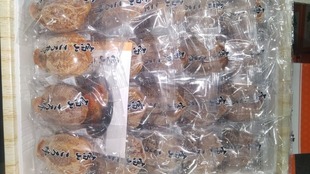
There is a proverb called Persimmon a day keeps the doctor away, but it seems to mean that “the season when the persimmons are colored has a good climate and the number of sick people decreases, so doctors are in trouble”, and the abundant nutrition and nourishment contained in the persimmons. The analogy is often used in Japan.

When the dried persimmons are dried, a work called “hand-rolled” is performed to evenly distribute the water and sugar content of the persimmons. This work is the same as it used to be, which was built by our predecessors, and it seems that it is done by hand and lovingly.
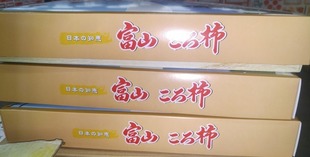
While each production area is drying with sunlight, we are the first to introduce a dryer nationwide, enabling early shipment and stable production. From the Kanto and Kansai markets, there are markets that are overwhelmingly larger than dried persimmons from other production areas, and are selling well for gifts and personal consumption, and are in high demand for gifts and are expected to increase production by about five times. It seems that it has been evaluated as a must-have item for the year-end and New Year holidays.
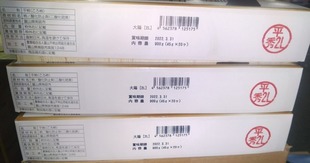
Making dried persimmons in Nanto City for about 360 years. Pick the well-grown persimmons, peel them, connect them with threads, disinfect them, and then dry them with a machine. During the drying process, the fruit is rubbed twice by human hands to shape it, and it takes time and effort. Cultivated items: Persimmon (Sanja, Hiratanenashi) Shipping period: During December 250 houses cultivated area 152 ha, obtained eco-farmer certification with reduced pesticides and no herbicides.
